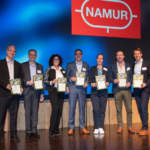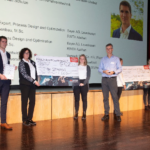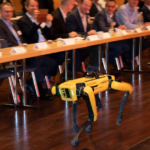After two years in online mode, the 85th Namur general meeting on November 10th and 11th, 2022, took place in person again. For the first time at the new location in Neuss. The focus this year was on the topic of safety. Almost 600 participants from the user groups of the process industry as well as invited guests from the manufacturers and partner organisations were able to find out which technological approach the sponsor Hima came up with for the motto ”Sustainable Lifecycle Risk Management”.
Dr. Felix Hanisch (Bayer) opened this year‘s event as Chairman of Namur. Also present for the first time were the new board members Dr. Frank van den Boomen (Covestro), Renatus Neijts (DOW) and Tobias Schlichtmann (BASF). And with it, for the first time, an international Executive Board.
Honoured for their services
The focus of the opening speech this year was the people who make up Namur. The badge of honor and special thanks for her many years of service went to Monika Reek, who went into well-deserved retirement last year and who has managed the Namur office with full commitment for over 22 years. Also Dr. Andreas Schadt was awarded the golden badge of honor for his active participation and the many important ideas that were brought in, especially with regard to the modularisation of the process industry.
Martin Schwibach was awarded honorary membership as the outgoing head of the department. In particular, his ”Schwibach‘sche Tunnelbrücke“ will accompany Namur for a long time to come. Dr. Thorsten Dreier (Covestro) as a former member of the Board of Management was also awarded as an honorary member.
Sponsorship lecture on Functional Safety
”Functional safety as DNA” – this is how Jörg de la Motte (CEO Hima) opened the sponsor‘s lecture entitled ”Safety goes digital”. He was supported by Sergeij Arent and Peter Sieber. 12 years ago, Hima laid the foundation for its first sponsorship of the Namur main conference on this topic. The safety platform from Hima enables the consistent digitisation of functional safety and thus forms the basis for the overarching goal of sustainable risk management over the entire system cycle. “Let‘s think ahead! Simply linking security to products is not enough,” Peter Sieber urged. Based on three theses – Security by design remains an illusion! / Functional safety requires harmony with security! / A successful attack on automation is predictable! – he explained how digitisation can be implemented safely and successfully.
Ethernet-APL for safety systems
In their presentation, Prof. Dr. Karl-Heinz Niemann (Hanover University) and Marc Risser (BASF) explained in a very entertaining way how Ethernet-APL can be implemented for safety systems. Ethernet-APL offers digital communication with up to 10 Mbit/s up to the sensor and is tailored to the process industry. It supplies field devices with electrical energy and can be used in Ex zones 1/0. For safety applications, an established protocol such as Peofinet is expanded to include an additional safety layer, eg Profisafe, in order to exchange physical measured values and additional diagnostic information between field devices and safety systems.
Cyber safety from the user’s perspective
Afterwards, Jens Wiesner (BSI) and Dirk Hablawetz (BASF) exchanged the different views on cyber safety from the point of view of authorities and users in a critical discourse. Put everything on one island, lock every control cabinet, activate communication links only when needed and only allow access to a few authorised employees. A well-secured security system looks like this or something similar in reality – or maybe not? Dirk Hablawetz (BASF) and Jens Wiesner (BSI) discussed new developments and possible threats that can arise from the increasing networking of security systems as digitalisation progresses. Parallels in the (historical) development of functional safety and cyber security were shown and classified. In addition to problems, ways out of the dilemma were also discussed, because digitisation will continue to progress.
Focus on life cycle and sustainability
Dr. Felix Hanisch concluded the morning with his presentation on the subject of “Safety in the context of life cycle and sustainability”. In this presentation, he looked at the entire life cycle of functional safety applications and put this and its high demand for resources in the context of the current sustainability debate. The following question was raised: Can we manage to reconcile high regulatory requirements with our competitiveness and can we proceed sufficiently efficiently to continue to have sufficient resources for process optimization and defossilisation?
Wide-ranging workshop program
The wide-ranging workshop program in the afternoon of the first day with 30 contributions reflected the activities of the Namur working groups on the one hand and gave the opportunity to delve deeper into the sponsor‘s technical solutions on the other. In addition, representatives of cooperation partners presented topics from their associations and current development statuses. Topics such as Module Type Package (MTP), Namur Open Architecture (NOA) and their connection with the approach of OPAF, APL, PAT sensors, security, safety and asset administration shell were dealt with. Anyone interested in Hima products could explore the sponsor‘s exhibition, which met with great interest.
Winner of the Namur Award
The second day traditionally began with the presentation of the Namur Award. Dr. Stefan Krämer (Bayer) congratulated the winner Yak Ortmanns on his master‘s thesis ”Application of reinforcement learning for process control in the industrial environment” at the RWTH Aachen University. A great work on the practicality of AI for process control.
On the way to climate neutrality
A topic as important and prominent as sustainability was of course also present at the main meeting. Dr. Klaus Schäfer (Covestro) described in his presentation “Full automation. zero emissions. / The role of digitsation on the way to climate neutrality.” how an energy-intensive company like Covestro can successfully pave the way to climate neutrality. Digitisation is a key enabler here. The vision: Fully digitised plants are safe, efficient, reliable, predictable, transparent, traceable, compliant and take demographic change into account.
Roboter for the process industry
Then the Namur auditorium was visited by a special guest: the walking robot spot from Boston Dynamics showed live how advanced the technology has become. In the accompanying lecture, Peter Welter (BASF) and Yannick Kleppinger (Merck) described how these can be used sensibly in the process industry. The prelude to this was offered by the innovation competition (Advanced Industrial Robotic Applications Challenge, abbreviated: AIRA Challenge), in which BASF, Bayer, Boehringer Ingelheim, Merck and Wacker jointly searched for innovative and autonomous solutions under the patronage of Namur eV with Invite GmbH, to automate routine activities in chemical plants.
Adoption of Cloud in OT
Cloud technologies have been shaping discussions in the traditional IT sector for years. The expectations are great, the promises even greater: infinite scalability, reduced costs, new business models and a completely new way of handling data – the cloud should deliver all of this. Equally controversial is the question of whether the supposed advantages of the cloud can be transferred from IT to OT. In the presentation by Sebastian Gau (BASF) and Christoph Berlin (Microsoft), the current adoption of cloud in OT was critically questioned, current and future challenges were analyzed and, ultimately, a way was shown of how the vision of Industry 4.0 can become reality in the process industry.
In his presentation, Frank van den Boomen brought in the perspective of the asset owner. Especially in his focus: What is the added value?
Next year‘s sponsor
At the Namur main meeting in 2023 one can look forward to the sponsor Schneider Electric, who will take up the motto ”Open Automation and Digitalization for Sustainability and Efficiency”. The meeting of the automation technology community in the process industry, which is always well attended, will take place again in Neuss on November 23 and 24, 2023.









